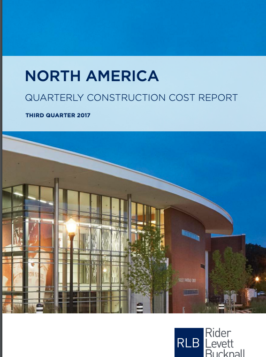Exclusive to the Q3 report, RLB includes a material price index, containing information especially relevant in the wake of the hurricanes that devastated parts of Texas, Florida, and Puerto Rico. It is likely that these catastrophic events will have some effect on nation’s construction costs. However, the affected areas and the adjacent states might see an increase of about 4%-6% above the national costs.
In the U.S., construction put-in-place ended at a seasonally-adjusted annual rate of $1.21 trillion, or 1.3% below the revised May estimate of $1.22 trillion. General unemployment remained steady while construction unemployment sees its first drop since this time last year. The AIA’s Architecture Billing Index (ABI), the leading economic indicator for non-residential activity, is up from the 2016 average with an ABI of 54.2, indicating a healthy year thus far.
National average construction costs increased approximately 4.27% between July 2016 and July 2017.
San Francisco and Los Angeles experienced the greatest increases in construction costs (8.49% and 6.75%, respectively), while Chicago, Portland, and Seattle had more modest increases, ranging from 5.65% to 5.30%. Honolulu experienced a -1.18% decrease in construction costs. All of this appears against a backdrop of a variable economy, which experienced a GDP of 3%, up from 1.2% in the second quarter of 2017.
Toronto and Calgary experience a decrease in construction
In Canada, housing starts are up 28.5% from last quarter, leaving the number of housing starts 3.3% higher than the same period in 2016. Unemployment holds steady at 6.5%, a sight fluctuation of 0.2% from the same period last year. The Consumer Price Index remains steady, with a variance of 1.4% from the same period last year. The GDP for construction fluctuates with a variance of less than 1%, ranging from -0.34% in the second quarter of 2016 to 1.09% in the second quarter of 2017.
About the Rider Levett Bucknall Quarterly Construction Cost Report
In its North American Quarterly Construction Cost report, RLB tracks construction costs in 12 American cities and two Canadian cities, providing a market-by-market look at construction costs. The report also surveys specific construction sectors—including hospitality, retail, healthcare, office, residential, industrial, and education—identifying low and high construction costs in each urban center.
Together with international and national cost compendia, the cost research equips clients with complete and relevant information to assist in key business decisions.
FURTHER INFORMATION:



